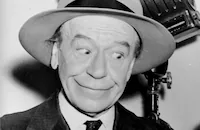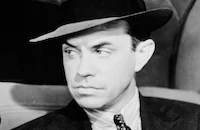Behind the Headlines

Brief Synopsis
Cast & Crew
Richard Rosson
Lee Tracy
Diana Gibson
Donald Meek
Paul Guilfoyle
Philip Huston
Film Details
Technical Specs

Synopsis
Eddie Haines, the "Rambling Radio Reporter" for New York station KBC, consistently scoops the local newspaper reporters with his live, on-the-scene reporting and consequently engenders their jealous ire. One newspaper journalist in particular, Mary Bradley, Eddie's former girl friend, is infuriated by the radio competition and does what she can, including hiring thugs, to stop the broadcasts and steal Eddie's equipment. When she is tricked and then kidnapped by Potter, a crooked Justice Department administrator who has conspired with the notorious Martin gang to steal a gold shipment bound for Fort Knox, Eddie heads for Louisville to find her. After the highway heist, the gang takes the truck and Mary to an obscure cave in the Kentucky mountains. Using the transmitter that she stole from Eddie, Mary surreptitiously broadcasts her plight, and F.B.I. agents are able to approximate her location from her signals. As Eddie and the F.B.I. zero in, the gangsters discover Mary's transmitter, and to save herself, she locks herself in the armored truck. With seconds to spare, Eddie and the F.B.I. locate the cave and rescue Mary from the greedy, murderous hands of Potter.

Director
Richard Rosson
Cast

Lee Tracy

Diana Gibson

Donald Meek

Paul Guilfoyle

Philip Huston
Frank M. Thomas

Tom Kennedy
Doodles Weaver
Ralph Robertson
Art Thalasso
Edith Craig
Crew
Thomas Ahearn
J. Robert Bren
Samuel J. Briskin
Howard Campbell
Denzil A. Cutler
Sid Fogel
Edmund L. Hartmann
Harry Marker
Russell Metty
Van Nest Polglase
Cliff Reid
Vernon L. Walker

Film Details
Technical Specs

Articles
Behind the Headlines
In Behind the Headlines Tracy plays fast-talking (what else?) radio reporter Eddie Haines, whose position with station KBC always gets him the scoop on the infuriated, jealous newsies at the New York Star, including ex-girlfriend Mary Bradley. But when Mary is kidnapped, Eddie and his colleagues in the print media join forces, combining their methods to rescue her.
The antagonism between print and broadcast media was a very real thing in the 1930s. The first national commercial radio broadcast was, in fact, a news story, a report on the 1920 presidential election. At first, there was cooperation between the two, and radio announcers limited themselves to reading newspaper headlines and briefs over the air. When the Associated Press began selling stories to the networks in 1932, newspapers objected, saying it would cause their demise, especially when the practice of interrupting programs with news bulletins became more widespread. CBS President William Paley called a meeting of publishers, network executives, and wire service representatives in 1933 to end the dispute with an agreement (called the Biltmore Agreement, after the hotel in which they met) that would limit network news broadcasts and curtail bulletins. In the end, however, this press-radio war failed to curb the growth of on-air news, and by the mid-30s, its success had become a given.
This film, then, slight as it is, is considered something of a milestone, credited as the first to feature radio as a major news broadcaster and reflecting the "war" between the two formats. The ease with which radio could get breaking stories on the air long before newspapers had even begun to set their type is evident in the film's working title, "Tomorrow's Headlines."
According to some sources, this was also the first film to use Fort Knox as a setting. And here's another bit of trivia: The radio truck used in the filming was borrowed from RKO cinematographer J. Roy Hunt, who built one for himself as a hobby.
Other than perennial (and aptly named) supporting player Donald Meek, you probably won't recognize much of the cast. The name of the cinematographer, however, should be familiar. Russell Metty began his career just a few years earlier, but by the 1940s he was working with some of Hollywood's top directors and building a reputation for sharp black-and-white contrast and night shooting, amply evident in his work for Orson Welles on The Stranger (1946) and Touch of Evil (1958). He was also praised for his color cinematography, receiving Academy Award nominations for Spartacus (1960) and Flower Drum Song (1961). He also did some stunning color work for director Douglas Sirk on Magnificent Obsession (1954), All That Heaven Allows (1955), and Imitation of Life (1959).
Director: Richard Rosson
Producer: Cliff Reid
Screenplay: Edmund L. Hartmann, J. Robert Bren; story by Thomas Ahearn
Cinematography: Russell Metty
Editing: Harry Marker
Art Direction: Van Nest Polglase
Cast: Lee Tracy (Eddie Haines), Diana Gibson (Mary Bradley), Phillip Huston (Alan Bennett), Paul Guilfoyle (Art Martin), Donald Meek (Potter)
By Rob Nixon

Behind the Headlines
Quotes
Trivia
The radio truck used in the film was borrowed from J. Roy Hunt who had built it for his own use.
Notes
The film's working title was Tomorrow's Headlines. Hollywood Reporter production charts add George Irving to the cast, but his participation in the final film has not been confirmed. According to modern sources, this film was the first to use Fort Knox as a setting, and the first to examine the role of radio in live news broadcasts. Modern sources also state that the radio truck used in the filming was borrowed from RKO cinematographer J. Roy Hunt, who built one for himself as a hobby.














